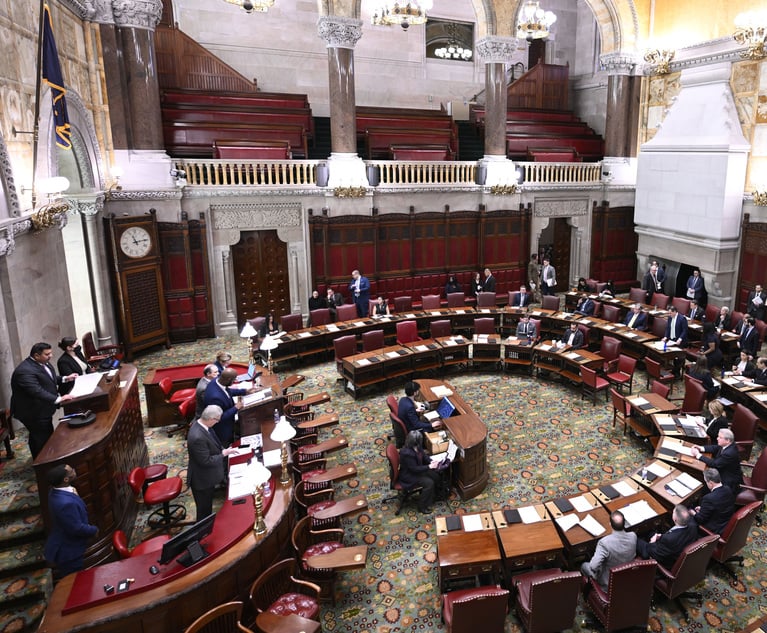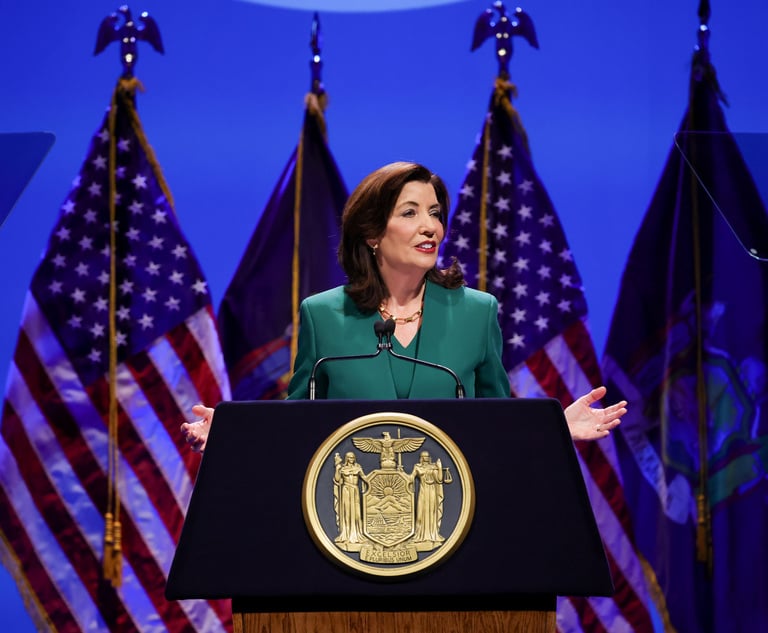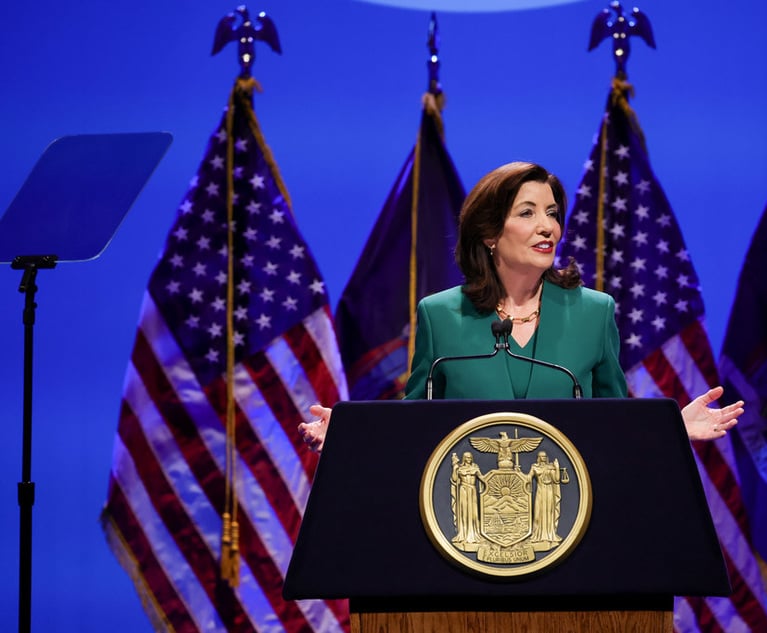Cuomo Threatens Lawsuit Against EPA Over Hudson River Cleanup
“The cleanup is not complete,” Cuomo said. “The Hudson River is a beautiful asset that we must preserve and protect and if there's any legal ability to sue, we will.
April 09, 2019 at 03:18 PM
6 minute read
 Sign reminding anglers to catch and release on the upper Hudson River (Photo: NYS.gov)
Sign reminding anglers to catch and release on the upper Hudson River (Photo: NYS.gov)
New York state will sue the U.S. Environmental Protection Agency if it gives General Electric a certificate of completion on cleaning up toxic chemicals in the Hudson River, Gov. Andrew Cuomo said in a radio interview on Tuesday.
The warning came after New York Department of Environmental Conservation Commissioner Basil Seggos told the Albany Times Union newspaper last week that the federal environmental agency is poised to offer the certificate, which would absolve GE of future liability.
GE had been involved in dredging a portion of the Hudson River for contaminants, called PCBs, until 2015, at which point the EPA allowed the work to end. Environmental advocates have called on the federal agency to require GE to dredge other parts of the Hudson where contaminants have traveled over time.
Cuomo didn't get quite that specific in his comments on Tuesday, but said, despite the EPA's findings, the job isn't done.
“The cleanup is not complete,” Cuomo said. “The Hudson River is a beautiful asset that we must preserve and protect and if there's any legal ability to sue, we will.”
It's a threat Cuomo has made before, but it gained new significance this week after Seggos confirmed the EPA may imminently be offering GE the certificate of completion.
GE has worked with the EPA for a few decades now on projects related to the Hudson River cleanup. The most recent involved years of dredging, or removal, of PCBs that the company had used and disposed of for nearly three decades before ending the practice in the 1970s. The company has removed more than 300,000 pounds of PCBs through its dredging of the Hudson River.
But state officials, including Cuomo and Seggos, have said that data obtained from the state has indicated that a significant amount of PCBs remain in the Hudson River. They want GE to resume its work cleaning up the river, which the company would not be required to do if given a certificate of completion by the EPA.
Cuomo said the state will have to consider what legal grounds, if any, New York will have to sue the EPA if it releases GE of future liability. He said he was “very afraid” of the possibility of permanently ending the cleanup project.
“We will sue them if there is any legal viability to the suit whatsoever. I'm very afraid of it,” Cuomo said. “This has been going on many years. I believe this federal government is just deaf to environmental concerns and here's a big corporation, GE, and this is ripe for a Trump doctrine of what's good for business is good for America.”
GE spokesman Mark Behan, meanwhile, pointed to the company's massive cleanup efforts along the Hudson, which have been going on for decades in different capacities. He said the dredging project has actually exceeded the standards set by the federal government before the work began.
“GE completed the Hudson River dredging project in 2015, having removed twice the volume of PCBs from the river than U.S. EPA envisioned and having met all of its commitments to EPA,” Behan said. “As result of dredging, PCB levels in sediment have dropped as much as 96 percent, and PCB levels in water have dropped at every monitoring station along the Hudson, with declines of as much as 78 percent.”
Behan also claimed the state's own data on the cleanup project, which focused on the upper Hudson River, showed the success of the project. Almost all of the samples taken in 2017 to measure the company's progress met the federal agency's standards, Behan said.
“EPA ordered the dredging project, with the concurrence of New York State. EPA and New York State oversaw the work, and the state was instrumental in every major decision about the project,” Behan said. “EPA officials have praised the project as an environmental success.”
The Cuomo administration has been on the heels of the dredging project since it was completed, calling for more work to be done before GE is absolved of total liability related to the contamination. Seggos told the Times Union that findings from the state of elevated PCB levels in fish should be enough to convince the EPA that the cleanup project is not finished.
The EPA is expected to release a final report on the effectiveness of the project sometime in the future, but the timing on the document's release is unclear. The federal agency has been looking at the project's results for more than two years now and said in a previous report that fish from the river contaminated with PCBs may not be safe to eat for at least five decades, according to the Times Union.
It would be far from the first time New York pursued litigation against the EPA during the administration of President Donald Trump. New York Attorney General Letitia James, in January, sued the EPA over claims that the agency had failed to regulate interstate smog, for example.
A spokeswoman for the EPA said they expect to make a decision on the certificate of completion in the “near term,” but noted that GE would still be on the hook to monitor the Hudson River going forward, regardless of the outcome.
“It is important to re-emphasize that no matter what EPA decides relative to the 'Certification of Completion of the Remedial Action,' GE is required to continue monitoring and sampling the Upper Hudson for decades to come with the understanding that if, at any time, it is shown that the remedy is not protective of human health or the environment, GE remains obligated to take additional action,” the spokeswoman said.
READ MORE:
NY AG James Leads Coalition in Interstate Smog Lawsuit Against US EPA
Federal Judge Strikes Down Trump Administration's Census Citizenship Question
Incoming NY AG James Vows to Press Cases Against Trump, White House
This content has been archived. It is available through our partners, LexisNexis® and Bloomberg Law.
To view this content, please continue to their sites.
Not a Lexis Subscriber?
Subscribe Now
Not a Bloomberg Law Subscriber?
Subscribe Now
NOT FOR REPRINT
© 2025 ALM Global, LLC, All Rights Reserved. Request academic re-use from www.copyright.com. All other uses, submit a request to [email protected]. For more information visit Asset & Logo Licensing.
You Might Like
View All
Relaxing Penalties on Discovery Noncompliance Allows Criminal Cases to Get Decided on Merit
5 minute read
Bipartisan Lawmakers to Hochul Urge Greater Student Loan Forgiveness for Public-Interest Lawyers

'Playing the Clock'?: Hochul Says NY's Discovery Loophole Is to Blame for Wide Dismissal of Criminal Cases

So Who Won? Congestion Pricing Ruling Leaves Both Sides Claiming Victory, Attorneys Seeking Clarification
4 minute readTrending Stories
- 1New York-Based Skadden Team Joins White & Case Group in Mexico City for Citigroup Demerger
- 2No Two Wildfires Alike: Lawyers Take Different Legal Strategies in California
- 3Poop-Themed Dog Toy OK as Parody, but Still Tarnished Jack Daniel’s Brand, Court Says
- 4Meet the New President of NY's Association of Trial Court Jurists
- 5Lawyers' Phones Are Ringing: What Should Employers Do If ICE Raids Their Business?
Who Got The Work
J. Brugh Lower of Gibbons has entered an appearance for industrial equipment supplier Devco Corporation in a pending trademark infringement lawsuit. The suit, accusing the defendant of selling knock-off Graco products, was filed Dec. 18 in New Jersey District Court by Rivkin Radler on behalf of Graco Inc. and Graco Minnesota. The case, assigned to U.S. District Judge Zahid N. Quraishi, is 3:24-cv-11294, Graco Inc. et al v. Devco Corporation.
Who Got The Work
Rebecca Maller-Stein and Kent A. Yalowitz of Arnold & Porter Kaye Scholer have entered their appearances for Hanaco Venture Capital and its executives, Lior Prosor and David Frankel, in a pending securities lawsuit. The action, filed on Dec. 24 in New York Southern District Court by Zell, Aron & Co. on behalf of Goldeneye Advisors, accuses the defendants of negligently and fraudulently managing the plaintiff's $1 million investment. The case, assigned to U.S. District Judge Vernon S. Broderick, is 1:24-cv-09918, Goldeneye Advisors, LLC v. Hanaco Venture Capital, Ltd. et al.
Who Got The Work
Attorneys from A&O Shearman has stepped in as defense counsel for Toronto-Dominion Bank and other defendants in a pending securities class action. The suit, filed Dec. 11 in New York Southern District Court by Bleichmar Fonti & Auld, accuses the defendants of concealing the bank's 'pervasive' deficiencies in regards to its compliance with the Bank Secrecy Act and the quality of its anti-money laundering controls. The case, assigned to U.S. District Judge Arun Subramanian, is 1:24-cv-09445, Gonzalez v. The Toronto-Dominion Bank et al.
Who Got The Work
Crown Castle International, a Pennsylvania company providing shared communications infrastructure, has turned to Luke D. Wolf of Gordon Rees Scully Mansukhani to fend off a pending breach-of-contract lawsuit. The court action, filed Nov. 25 in Michigan Eastern District Court by Hooper Hathaway PC on behalf of The Town Residences LLC, accuses Crown Castle of failing to transfer approximately $30,000 in utility payments from T-Mobile in breach of a roof-top lease and assignment agreement. The case, assigned to U.S. District Judge Susan K. Declercq, is 2:24-cv-13131, The Town Residences LLC v. T-Mobile US, Inc. et al.
Who Got The Work
Wilfred P. Coronato and Daniel M. Schwartz of McCarter & English have stepped in as defense counsel to Electrolux Home Products Inc. in a pending product liability lawsuit. The court action, filed Nov. 26 in New York Eastern District Court by Poulos Lopiccolo PC and Nagel Rice LLP on behalf of David Stern, alleges that the defendant's refrigerators’ drawers and shelving repeatedly break and fall apart within months after purchase. The case, assigned to U.S. District Judge Joan M. Azrack, is 2:24-cv-08204, Stern v. Electrolux Home Products, Inc.
Featured Firms
Law Offices of Gary Martin Hays & Associates, P.C.
(470) 294-1674
Law Offices of Mark E. Salomone
(857) 444-6468
Smith & Hassler
(713) 739-1250






